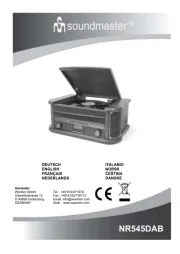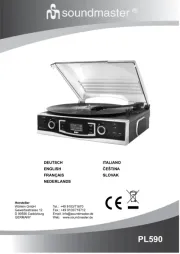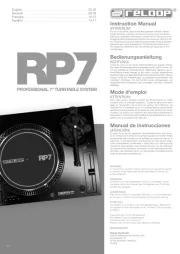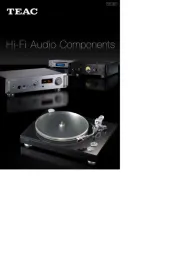Pyle PMX648 Bruksanvisning
Pyle
Skivspelare
PMX648
Läs gratis den bruksanvisning för Pyle PMX648 (9 sidor) i kategorin Skivspelare. Guiden har ansetts hjälpsam av 13 personer och har ett genomsnittsbetyg på 4.7 stjärnor baserat på 7 recensioner. Har du en fråga om Pyle PMX648 eller vill du ställa frågor till andra användare av produkten? Ställ en fråga
Sida 1/9

Questions? Issues?
We are here to help!
Phone: (1) 718-535-1800
Email: support@pyleusa.com
Produktspecifikationer
| Varumärke: | Pyle |
| Kategori: | Skivspelare |
| Modell: | PMX648 |
| Färg på produkten: | Zwart |
| Justerbar i höjdled: | Ja |
| Skärm diagonal: | 37 " |
| Upplösning: | 3840 x 1600 Pixels |
| Pekskärm: | Nee |
| Original bildförhållande: | 21:9 |
| Videolägen som stöds: | 1600p |
| Betraktningsvinkel, horisontell: | 178 ° |
| Betraktningsvinkel, vertikal: | 178 ° |
| Skärmform: | Gebogen |
| Typiskt kontrastförhållande: | 1000:1 |
| Frekvensområde horisontellt: | 30 - 130 kHz |
| Frekvensområde vertikalt: | 30 - 75 Hz |
| Antal HDMI-portar: | 1 |
| DVI-port: | Nee |
| Inbyggda högtalare: | Ja |
| Genomsnittlig effekt: | 14 W |
| Strömförbrukning (i standby): | 0.5 W |
| Antal högtalare: | 2 |
| Certifiering: | MPR II |
| Display, antal färger: | 1.073 biljoen kleuren |
| Strömförbrukning (när avstängd): | 0.5 W |
| Maximal uppdateringshastighet: | 75 Hz |
| HD typ: | UltraWide Quad HD+ |
| HDMI: | Ja |
| Displayteknik: | LED |
| Respons tid: | 4 ms |
| Grafikupplösningar som stöds: | 3840 x 1600 |
| VESA montering: | Ja |
| Panelmonteringsgränssnitt: | 100 x 100 mm |
| Ljusstyrka (typiskt): | 300 cd/m² |
| Bildförhållande: | 21:9 |
| Kontrastförhållande (dynamisk): | 100000000:1 |
| Djup (utan bas): | 123.6 mm |
| Höjd (utan bas): | 401.2 mm |
| Bredd (utan bas): | 896.9 mm |
| Vikt (utan bas): | 7810 g |
| Antal DisplayPorts: | 1 |
| Enhetsbredd (med stativ): | 896.9 mm |
| Djupenhet (med stativ): | 309 mm |
| Enhetshöjd (med stativ): | 587.7 mm |
| Vikt (med stativ): | 12300 g |
| AMD FreeSync: | Ja |
| Version USB-hubb: | 3.2 Gen 1 (3.1 Gen 1) |
| Strömförbrukning (PowerSave): | 58 W |
| Typ av bakgrundsbelysning: | LED |
| Mobile High-Definition Link (MHL): | Ja |
| Typ av panel: | IPS |
| Roterbar: | Ja |
| Horisontellt vridbar: | -45 - 45 ° |
| Inbyggd USB-hubb: | Ja |
| sRGB-täckning (genomsnitt): | 100 procent |
| Stöd för VESA Adaptive Sync: | Ja |
| Strömförbrukning (typiskt): | 61 W |
| Tiltvinkelområde: | -5 - 20 ° |
| lutningsjusteringar: | Ja |
Behöver du hjälp?
Om du behöver hjälp med Pyle PMX648 ställ en fråga nedan och andra användare kommer att svara dig
Skivspelare Pyle Manualer

4 Januari 2025

9 Oktober 2024

30 September 2024

19 September 2024

19 September 2024

28 Augusti 2024

25 Augusti 2024

24 Augusti 2024

21 Augusti 2024

18 Augusti 2024
Skivspelare Manualer
- Rekkord
- Elta
- 1byOne
- Musical Fidelity
- Sherwood
- Jam
- Technaxx
- Amazon
- Victrola
- Medion
- Kenwood
- Elac
- AVM
- Pioneer
- Sony
Nyaste Skivspelare Manualer

19 Oktober 2025

19 Oktober 2025

18 Oktober 2025

18 Oktober 2025

16 Oktober 2025

11 Oktober 2025

11 Oktober 2025

11 Oktober 2025

10 Oktober 2025

10 Oktober 2025